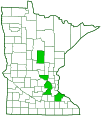oak flake gall wasp
(Neuroterus quercusverrucarum)
Conservation • Description • Habitat • Ecology • Distribution • Taxonomy
|
|
|||||||||||||
Description |
Oak flake gall wasp is a very small cynipid gall wasp. It is best identified by the gall it produces. The galls are found on the underside of leaves of bur oak and swamp white oak. They occur singly though there are usually several galls on any one leaf. They are hemispherical, thickly hairy, and ⅛″ to 3 ⁄16″ in diameter including the hairs. The hairs are white at first but soon turn brown. Each gall contains a single chamber and a single wasp larva. It is revealed on the upper leaf surface as a smooth blister-like bump. The adult wasp is short-lived, about 1 ⁄16″ to ⅛″ long, and appears hump-backed. It does not sting. The head is black. The antennae are thread-like, not elbowed, and have 13 to 16 segments. The thorax is black and rough. When seen from the side, the plate covering the first segment of the thorax (pronotum) is more or less triangular in shape and reaches nearly to the plate at the base of the forewing (tegula). The abdomen is black, shiny, oval, and somewhat compressed. When viewed from above only two abdominal segments are visible. The egg-laying structure (ovipositor) of the female emerges on the underside of the abdomen before the tip. It is permanently extended and cannot be withdrawn into the abdomen. The wings are clear with a few dark brown veins and fewer than 6 closed cells. The first segment of the hind foot (tarsus) is about as long as the next two or three combined. |
Size |
Wasp: 1 ⁄16″ to ⅛″ long Gall: ⅛″ to 3 ⁄16″ in diameter |
Similar Species |
Oak gall wasp (Neuroterus exiguissimus) is found on white oak. |
Habitat |
Anywhere host species are found |
Ecology |
Season |
Spring |
Behavior |
|
Life Cycle |
The larva pupates in the fall and overwinters in the gall. Adults emerge in the spring. A small, circular hole in the side of a gall indicates where the wasp has emerged, though this is obscured by the hairs. |
Larva Hosts |
Adult Food |
Adult wasps do not feed. |
Distribution |
||
|
Sources The map includes records for both Neuroterus quercusverrucarum and Neuroterus floccosus. |
|
| 8/4/2024 | ||
Occurrence |
||
|
||
Taxonomy |
|
Order |
Hymenoptera (Ants, Bees, Wasps, and Sawflies) |
Suborder |
Apocrita (narrow-waisted wasps, ants, and bees) |
Infraorder |
Proctotrupomorpha |
Superfamily |
Cynipoidea (gall wasps and allies) |
Family |
Cynipidae (gall wasps) |
Subfamily |
Cynipinae |
Tribe |
Cynipini (oak gall wasps) |
Genus |
Neuroterus |
This species, as it occurs in Minnesota, was formerly treated as Neuroterus floccosus. A study of cynipid gall wasps from the eastern United States (Melika and Abrahamson, 1997) found no morphological differences in adults, galls, and phenology of N. quercusverrucarum, N. exiguissimus, and N. floccossus. The authors treat the latter two as synonyms of the first. The change has not been universally accepted. BugGuide treats N. flocossus as a synonym of N. quercusverrucarum. GBIF, NCBI, and Discover Life recognize each as separate species. |
|
Subordinate Taxa |
|
|
|
Synonyms |
|
Cynips flocossa Cynips quercus verrucarum Cynips verrucarum Neuroterus exiguissimus Neuroterus floccosus Neuroterus verrucarum |
|
Common Names |
|
oak flake gall wasp |
|
Glossary
Gall
An abnormal growth on a plant produced in response to an insect larva, mite, bacteria, or fungus.
Ovipositor
A tube-like organ near the end of the abdomen of many female insects, used to prepare a place for an egg and to place the egg.
Pronotum
The exoskeletal plate on the upper side of the first segment of the thorax of an insect.
Tarsus
On insects, the last two to five subdivisions of the leg, attached to the tibia; the foot. On spiders, the last segment of the leg. Plural: tarsi.
Tegula
A small, hardened, plate, scale, or flap-like structure that overlaps the base of the forewing of insects in the orders Lepidoptera, Hymenoptera, Diptera, and Homoptera. Plural: tegulae.
Visitor Photos |
||
Share your photo of this insect. |
||
This button not working for you? |
||
BWO |
||
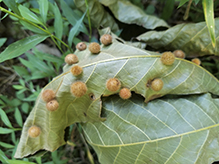 |
|
|
MinnesotaSeasons.com Photos |
||
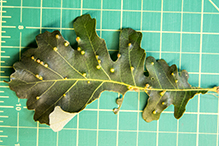 |
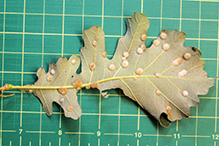 |
|
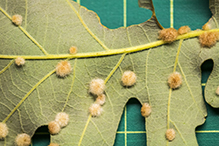 |
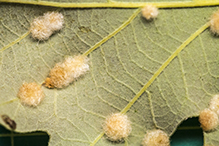 |
|
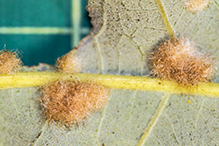 |

Slideshows |
|

Visitor Videos |
||
Share your video of this insect. |
||
This button not working for you? |
||
|
Other Videos |
||
|

Visitor Sightings |
||
Report a sighting of this insect. |
||
This button not working for you? |
||
Jamie Mckenney |
Location: Balsam, Itasca County on our oak |
|
| BWO 9/2/2019 |
Location: Matthew's, NC 28105 |
 |
MinnesotaSeasons.com Sightings |
||

Created: 8/28/2015 Last Updated: © MinnesotaSeasons.com. All rights reserved. |
